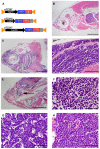A zebrafish transgenic model of Ewing's sarcoma reveals conserved mediators of EWS-FLI1 tumorigenesis
- PMID: 21979944
- PMCID: PMC3255547
- DOI: 10.1242/dmm.007401
A zebrafish transgenic model of Ewing's sarcoma reveals conserved mediators of EWS-FLI1 tumorigenesis
Abstract
Ewing's sarcoma, a malignant bone tumor of children and young adults, is a member of the small-round-blue-cell tumor family. Ewing's sarcoma family tumors (ESFTs), which include peripheral primitive neuroectodermal tumors (PNETs), are characterized by chromosomal translocations that generate fusions between the EWS gene and ETS-family transcription factors, most commonly FLI1. The EWS-FLI1 fusion oncoprotein represents an attractive therapeutic target for treatment of Ewing's sarcoma. The cell of origin of ESFT and the molecular mechanisms by which EWS-FLI1 mediates tumorigenesis remain unknown, and few animal models of Ewing's sarcoma exist. Here, we report the use of zebrafish as a vertebrate model of EWS-FLI1 function and tumorigenesis. Mosaic expression of the human EWS-FLI1 fusion protein in zebrafish caused the development of tumors with histology strongly resembling that of human Ewing's sarcoma. The incidence of tumors increased in a p53 mutant background, suggesting that the p53 pathway suppresses EWS-FLI1-driven tumorigenesis. Gene expression profiling of the zebrafish tumors defined a set of genes that might be regulated by EWS-FLI1, including the zebrafish ortholog of a crucial EWS-FLI1 target gene in humans. Stable zebrafish transgenic lines expressing EWS-FLI1 under the control of the heat-shock promoter exhibit altered embryonic development and defective convergence and extension, suggesting that EWS-FLI1 interacts with conserved developmental pathways. These results indicate that functional targets of EWS-FLI1 that mediate tumorigenesis are conserved from zebrafish to human and provide a novel context in which to study the function of this fusion oncogene.
Figures





Similar articles
-
Junction region of EWS-FLI1 fusion protein has a dominant negative effect in Ewing's sarcoma in vitro.BMC Cancer. 2012 Nov 12;12:513. doi: 10.1186/1471-2407-12-513. BMC Cancer. 2012. PMID: 23145994 Free PMC article.
-
The evaluation of CD99 immunoreactivity and EWS/FLI1 translocation by fluorescence in situ hybridization in central PNETs and Ewing's sarcoma family of tumors.Pathol Oncol Res. 2011 Sep;17(3):619-25. doi: 10.1007/s12253-010-9358-3. Epub 2011 Jan 26. Pathol Oncol Res. 2011. PMID: 21267687
-
Small-molecule screen identifies modulators of EWS/FLI1 target gene expression and cell survival in Ewing's sarcoma.Int J Cancer. 2012 Nov 1;131(9):2153-64. doi: 10.1002/ijc.27472. Epub 2012 Mar 29. Int J Cancer. 2012. PMID: 22323082
-
Promiscuous partnerships in Ewing's sarcoma.Cancer Genet. 2011 Jul;204(7):351-65. doi: 10.1016/j.cancergen.2011.07.008. Cancer Genet. 2011. PMID: 21872822 Free PMC article. Review.
-
Ewing's sarcoma oncoprotein EWS-FLI1: the perfect target without a therapeutic agent.Future Oncol. 2005 Aug;1(4):521-8. doi: 10.2217/14796694.1.4.521. Future Oncol. 2005. PMID: 16556028 Review.
Cited by
-
Optimal management of Ewing sarcoma family of tumors: recent developments in systemic therapy.Paediatr Drugs. 2013 Dec;15(6):473-92. doi: 10.1007/s40272-013-0037-1. Paediatr Drugs. 2013. PMID: 23760780 Review.
-
A fresh look at zebrafish from the perspective of cancer research.J Exp Clin Cancer Res. 2015 Aug 12;34(1):80. doi: 10.1186/s13046-015-0196-8. J Exp Clin Cancer Res. 2015. PMID: 26260237 Free PMC article. Review.
-
Zebrafish-based platform for emerging bio-contaminants and virus inactivation research.Sci Total Environ. 2023 May 10;872:162197. doi: 10.1016/j.scitotenv.2023.162197. Epub 2023 Feb 11. Sci Total Environ. 2023. PMID: 36781138 Free PMC article. Review.
-
Optical Control of Tumor Induction in the Zebrafish.Sci Rep. 2017 Aug 23;7(1):9195. doi: 10.1038/s41598-017-09697-x. Sci Rep. 2017. PMID: 28835665 Free PMC article.
-
Zebrafish cancer: the state of the art and the path forward.Nat Rev Cancer. 2013 Sep;13(9):624-36. doi: 10.1038/nrc3589. Nat Rev Cancer. 2013. PMID: 23969693 Free PMC article. Review.
References
-
- Amatruda J. F., Patton E. E. (2008). Genetic models of cancer in zebrafish. Int. Rev. Cell Mol. Biol. 271, 1–34 - PubMed
-
- Baer C., Nees M., Breit S., Selle B., Kulozik A. E., Schaefer K. L., Braun Y., Wai D., Poremba C. (2004). Profiling and functional annotation of mRNA gene expression in pediatric rhabdomyosarcoma and Ewing’s sarcoma. Int. J. Cancer 110, 687–694 - PubMed
-
- Baird K., Davis S., Antonescu C. R., Harper U. L., Walker R. L., Chen Y., Glatfelter A. A., Duray P. H., Meltzer P. S. (2005). Gene expression profiling of human sarcomas: insights into sarcoma biology. Cancer Res. 65, 9226–9235 - PubMed
Publication types
MeSH terms
Substances
Grants and funding
LinkOut - more resources
Full Text Sources
Molecular Biology Databases
Research Materials
Miscellaneous

